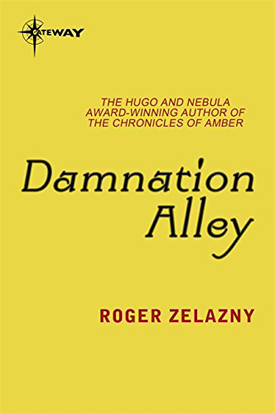 It’s a truism at this point that if you don’t know the work of Roger Zelazny, you are not equipped to deal with contemporary science fiction. Zelazny is often given major credit for reshaping the genre as one of the leading voices of the New Wave of the 1960s and ’70s, and with good reason. (One can argue this matter, obviously: there are contenders here in both the American and British versions of the New Wave such that no one author, I think, can be said to be the major force, and of course that doesn’t address the contribution of editors such as Michael Moorcock. But, all things considered, Zelazny will do as an icon.)
It’s a truism at this point that if you don’t know the work of Roger Zelazny, you are not equipped to deal with contemporary science fiction. Zelazny is often given major credit for reshaping the genre as one of the leading voices of the New Wave of the 1960s and ’70s, and with good reason. (One can argue this matter, obviously: there are contenders here in both the American and British versions of the New Wave such that no one author, I think, can be said to be the major force, and of course that doesn’t address the contribution of editors such as Michael Moorcock. But, all things considered, Zelazny will do as an icon.)
One of the key elements of Zelazny’s work was his complete disregard for the boundaries between science fiction, fantasy, and mainstream literature. Consider that, within a science fiction framework he frequently introduced mythological characters, not as mythic archetypes but as actual characters, and pushed the boundaries of what was acceptable stylistically within the genre into more widely accepted literary conventions.
And, having said that, I’m faced with Damnation Alley, a novel from early in his career (1969) that seems, on its surface, to undercut my points. It’s another “after the Apocalypse” story: the atomic war has happened and North America now holds two centers of human civilization, California and Boston. There is plague in Boston, and a plea for help has come: California has the necessary serum, but how to get it across the continent? Enter Hell Tanner, biker, thug, smuggler, and general ne’er-do-well, and also one of the few people who have been any distance toward the east. He drives the second car of three that will attempt the trip.
It’s an odyssey, in plain terms, and told in a tight, spare narrative that makes one wonder why we demand such lengthy books these days — as though we were buying them by the pound. Aside from the quality of the writing — even the dialogue, which was as far as I’m concerned always Zelazny’s weak point, is fluent and tight. And then when you stop to think about it, your first impressions start to fall apart.
The universe here is fantastic in the extreme: the workings of the world have little rational basis — rivers of garbage in the sky that periodically collide and dump their contents on whatever or whoever is beneath them don’t really hold up to even rudimentary inspection — and sometimes seem almost trite. (Why was it that radiation-induced mutations in the apocalyptic novels of the period so frequently wound up as enormous reptiles? One suspects a pernicious influence from the Hollywood FX people of the time.) Whatever — Zelazny makes you swallow it whole and like it. The writing is that good.
The meat of this story, however, is Hell Tanner himself, as unlikely an Odysseus as ever was. I had to think about his character for a while before I realized that he is truly a Zelazny creation, albeit more subtle than overt: Tanner is the Trickster, but not the double-dealing jokester who so often fills that role. Tanner is the creator/destroyer, the one who walks outside the law and works only toward his own purposes. I think it’s because of this that, in spite of what we know of his history and attitudes, we are not really surprised at his moments of compassion, nor that his own goals can go well into altruism, as witness his determination to fulfill his mission of bringing rescue to Boston: Prometheus was a Trickster, too.
Subtlety is not something I’ve often thought about in relation to Zelazny, but Damnation Alley forced me to reconsider: there’s much more under the surface of this particular adventure story than one would at first suspect. It’s a nice feeling.
(Gollancz, 2003 [orig. pub. 1969])
